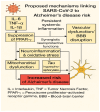The Molecular Mechanisms of Cognitive Dysfunction in Long COVID: A Narrative Review
- PMID: 40507911
- PMCID: PMC12154490
- DOI: 10.3390/ijms26115102
The Molecular Mechanisms of Cognitive Dysfunction in Long COVID: A Narrative Review
Abstract
Cognitive dysfunction represents one of the most persistent and disabling features of Long COVID, yet its molecular underpinnings remain incompletely understood. This narrative review synthesizes current evidence on the pathophysiological mechanisms linking SARS-CoV-2 infection to long-term neurocognitive sequelae. Key processes include persistent neuroinflammation, blood-brain barrier (BBB) disruption, endothelial dysfunction, immune dysregulation, and neuroendocrine imbalance. Microglial activation and cytokine release (e.g., IL-6, TNF-α) promote synaptic dysfunction and neuronal injury, while activation of inflammasomes such as NLRP3 amplifies CNS inflammation. Vascular abnormalities, including microthrombosis and BBB leakage, facilitate the infiltration of peripheral immune cells and neurotoxic mediators. Hypothalamic-pituitary-adrenal axis dysfunction and reduced vagal tone further exacerbate systemic inflammation and autonomic imbalance. Biomarkers such as GFAP, NFL, IL-6, and S100B have been associated with both neuroinflammation and cognitive symptoms. Notably, transcriptomic signatures in Long COVID overlap with those observed in Alzheimer's disease, highlighting shared pathways involving tau dysregulation, oxidative stress, and glial reactivity. Understanding these mechanisms is critical for identifying at-risk individuals and developing targeted therapeutic strategies. This review underscores the need for longitudinal research and integrative biomarker analysis to elucidate the molecular trajectory of cognitive impairment in Long COVID.
Keywords: cognitive dysfunction; long-COVID; neuroinflammation.
Conflict of interest statement
The authors declare no conflicts of interest.
Figures
Similar articles
-
SARS-CoV-2 spike S1 protein induces microglial NLRP3-dependent neuroinflammation and cognitive impairment in mice.Exp Neurol. 2025 Jan;383:115020. doi: 10.1016/j.expneurol.2024.115020. Epub 2024 Oct 18. Exp Neurol. 2025. PMID: 39428044
-
Inflammation at the crossroads of COVID-19, cognitive deficits and depression.Neuropharmacology. 2022 May 15;209:109023. doi: 10.1016/j.neuropharm.2022.109023. Epub 2022 Mar 4. Neuropharmacology. 2022. PMID: 35257690 Free PMC article. Review.
-
Omics-based analysis of mitochondrial dysfunction and BBB integrity in post-COVID-19 sequelae.Sci Rep. 2024 Dec 28;14(1):31016. doi: 10.1038/s41598-024-82180-6. Sci Rep. 2024. PMID: 39730725 Free PMC article.
-
Cerebromicrovascular mechanisms contributing to long COVID: implications for neurocognitive health.Geroscience. 2025 Feb;47(1):745-779. doi: 10.1007/s11357-024-01487-4. Epub 2025 Jan 7. Geroscience. 2025. PMID: 39777702 Free PMC article. Review.
-
Blood-brain barrier disruption and sustained systemic inflammation in individuals with long COVID-associated cognitive impairment.Nat Neurosci. 2024 Mar;27(3):421-432. doi: 10.1038/s41593-024-01576-9. Epub 2024 Feb 22. Nat Neurosci. 2024. PMID: 38388736 Free PMC article.
References
-
- Reese J.T., Blau H., Casiraghi E., Bergquist T., Loomba J.J., Callahan T.J., Laraway B., Antonescu C., Coleman B., Gargano M., et al. Generalisable long COVID subtypes: Findings from the NIH N3C and RECOVER programmes. EBioMedicine. 2023;87:104413. doi: 10.1016/j.ebiom.2022.104413. - DOI - PMC - PubMed
-
- World Health Organization (WHO) Post-COVID-19 Condition. [(accessed on 15 February 2025)]. Available online: https://www.who.int/europe/news-room/fact-sheets/item/post-COVID-19-cond....
Publication types
MeSH terms
Substances
LinkOut - more resources
Full Text Sources
Medical
Miscellaneous





